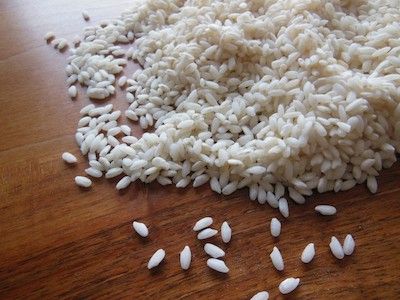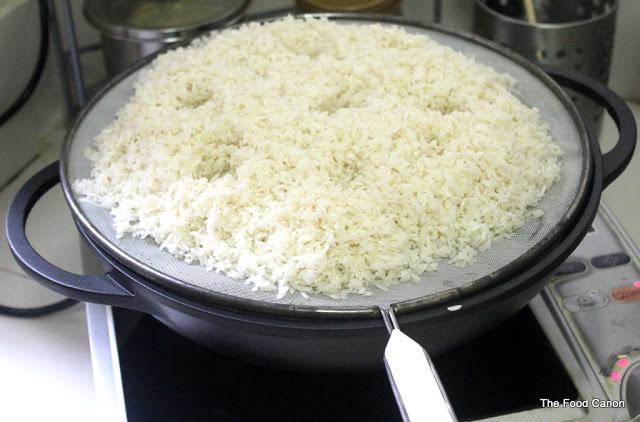We are reader supported. When you purchase through links on our site, we may earn an affiliate commission. Also, as an Amazon affiliate, we earn from qualifying purchases.

If you talk about Asian cuisine, sticky rice inevitably finds its way as it is arguably one of the most unique types of rice in existence. The distinct flavor, aroma, and texture make it stand apart from other types of rice. The oval and round shape also makes it easily identifiable.
So, what kind of rice is sticky rice? Also known as glutinous rice, the sticky rice is found mainly in the east and southeast Asia. This type of rice has a low amylose content and it is easily distinguished from other varieties of rice for containing just one starch element called amylopectin. It is used in making a variety of delicacies around the world.
Although the rice is glutinous or sticky in texture, it does not contain gluten which is found in other types of rice. The name “sticky rice” is derived from the fact that the grains clump together when they are cooked. Read on to find out more.
Contents
How To Prepare Sticky Rice
When cooking rice, there are two essential factors to consider – water absorption and the breakdown of the starch by heat. Before cooking, you must soak the rice in water to reduce the amount of heat if you do not have a steamer. So, how can you prepare sticky rice without a steamer? Let’s find out.
Using a splatter screen
Unlike the conventional rice steamers, a splatter screen like this will come in handy in saving space. Using a splatter screen is easy and is as follows:
- Start by soaking the rice for not less than two hours and drain it.
- Boil water in a large pot or deep pan and place the splatter guard on the pot.
- When the water starts boiling, reduce the heat to simmer. Put the rice on the platter screen and cover the rice. The best object to cover the rice is one with a dome shape. This will ensure it traps more steam to enhance the cooking process.
- Steam your rice for 35-40 minutes. When halfway cooking, turn the rice to ensure it cooks properly.
- Once the rice has been steamed for the proper duration, remove it from the splatter screen and serve.
Using a tinfoil
Just like a splatter screen, tinfoil relies on steam to cook the rice. Aluminum foil will come in handy in using this rice steaming alternative. The is process is really easy.
- Soak the amount of rice you want to cook in water for not less than two hours
- Boil water in a pot that isn’t too deep
- Cover the top of the pot using a large sheet of aluminum foil. and place the rice on it. Also, do not forget to seal the sides of the pot. The holes will enable the steam to reach the rice.
- Once everything is ready, cover the rice with a dome shaped lid to retain more heat.
Using a strainer
A strainer can have many uses at home. To use this equipment, you only need a simple trick.
- Soak your rice for at least 2 hours
- Boil water
- Place the strainer on the pot guard upside down. This will ensure the rice does not touch the water. Place the rice on the surface of the strainer to steam. Find a lid to cover the rice and make sure it does not touch the rice.
The best strainer to use is one with a wire mesh. A plastic one may melt and leave chemical drops on your rice.
Tips To Make Good Sticky Rice
The sticky rice becomes translucent and sticker in texture when allowed to cook in its own steam after the gas has been turned off.
If you want the sticky rice to be very sticky, allow it to cool down properly or refrigerate it before using it.
You can store the sticky rice covered in the refrigerator but make sure you consume it within a day or two as the rice tends to harden up fast.
Sticky rice cooks quickly so use a fork to pull the rice aside and check in between. If there’s some water left, let the rice cook for another 5-10 minutes.
When the rice is cooked, make sure you cover it with a tight lid as this can help keep the rice warm for longer.
Making Regular Or Non-Sticky Rice Sticky
Sticky rice is typically made from a special type of glutinous grain, but what if you don’t find it in the stores near you. Also, in cases when you are craving for some sticky rice but don’t want to make that trip to the grocery store, here’s a nice way to turn non-sticky rice sticky.
Measure the amount of rice you wish to cook and skip the rinsing process. Let the grains be covered in starch as this is what gives starchiness to the rice.
I would recommend that you use short-grain rice as it has a higher level of stickiness. However, you may also use medium grain or long grain rice.
If you can’t bear the thought of eating rice without washing it then I would recommend that you wash just once or twice to not strip the rice of all its starch.
Soak the rice as this helps in making rice stickier. You can soak rice for 30 minutes or up to 4 hours depending on how sticky you want the rice to be. Drain the water once the rice is soaked.
Now, add water to the pan. Take twice as much as measured rice. So, if you have taken one cup of rice, add two cups of water plus some extra to achieve a sticky texture. Let the water heat up slightly.
Add a dash of salt to give some flavor to the rice or else it will taste bland. Add rice to the water and let it cook for 10 minutes uncovered.
When all water is absorbed, just turn off the heat and put the lid on the pan. Let the rice sit over the stove for another 10 minutes and allow it to become stickier.
Health benefits of eating sticky rice
Sticky rice has numerous health benefits especially when it comes to regulating diseases. Some of the ailments that are regulated by sticky rice are:
- Chronic ailments
Sticky rice contains vital vitamins and minerals like selenium which are antioxidants. These antioxidants help to reduce oxidative stress thus preventing you from contracting a chronic disease.
- Inflammation
Inflammation in the body is caused by different factors and can prove to be fatal. Fortunately, sticky rice contains important minerals like B vitamins, copper and zinc. These vitamins play a crucial role of boosting the immune system. With improved immunity, you stand minimal risks of straining your system or inflammation.
- Bone density
As you age, the strength of your bones is bound to decrease. But by eating sticky rice, you reduce the risk of osteoporosis and improve the health of your bones.
- Cardiac health
Owing to the fact that sticky rice is steamed and not boiled, it does not come into contact with any fat or cholesterol. The lack of these health-threatening elements means your cardiac health is not at risk. In addition, sticky rice is perfect for people suffering from high blood pressure, heart conditions or being overweight.
- Metabolism
Sticky rice contains an array of B vitamins which are essential in enhancing the metabolic rate. These vitamins induce important metabolic processes like creating enzymes and balancing hormones.
Reference: https://www.sciencedirect.com/science/article/pii/S0308814613000150
Amazing facts about sticky rice
1. Sticky rice is a staple food in some locations
Sticky rice is largely associated with Thailand. However, it is consumed in higher rates at the neighboring country Laos. In fact, the citizens of Laos consider sticky rice to be their staple food. Sticky rice is grown in the Uplands and Lowlands of Laos.
2. Sticky rice is consumed using hands
Now that sticky rice is the staple food in Laos, they accord it great respect. Unlike other types of rice that cannot be eaten by hand, the people of Laos eat sticky rice using their hands.
3. Sticky rice is available in different colors
Sticky rice is available in hulled or unhulled state. Hulled sticky rice is usually white in color. On the other hand, unhulled sticky rice may come in black or purple. The unhulled type of sticky rice is pretty rare and quite expensive.
4. Sticky rice has always been steamed
Ever since sticky rice was discovered, it has never been boiled. The most adopted preparation method is steaming.
5. Sticky rice does not contain gluten
Sticky rice does not contain gluten. This explains why it is the ideal dish for anyone who is grappling with weight issues.
6. Sticky rice takes time to digest
Compared to regular rice, sticky rice takes longer to be digested. This specialty rice is loved by monks since it keeps them full the whole day after only eating once.
7. Sticky rice can be used to make desserts
One of the best desserts in the world consists of sticky rice. This dessert (Kha Nia Moan) is popular in Thailand and comprises sticky rice with coconut milk sauce and fresh mango.
Related Questions
Is there a difference between sticky rice and white rice?
There is a huge difference between the two types of rice. White rice/long grain rice contains two starch components (amylose and amylopectin). In regular rice, the amylose levels are high thus it does not clump when cooked. On the other hand, sticky rice mainly contains amylopectin which quickly breakdown upon heating hence causing it to clump together.
Is sticky rice better than white rice?
The nutrients contained in the two types of rice are quite different. White rice has a high glycemic index which increases the blood sugar levels in the body. Sticky rice contains high levels of fiber which are ideal in regulating the blood sugar levels in the body. On the other hand, white rice requires boiling which means it may come into contact with fat. Constant consumption of fat will increase cholesterol levels in your body thus putting you at risk of chronic ailments.
Related Article: Can You Make Sushi with Brown Rice?
Can you make sticky rice using regular rice?
Of course, you can. You may use medium-grain or long-grain rice to make sticky rice by following the instructions provided above. You simply need to soak the regular rice in water for not more than 30 minutes. Soaking the regular rice enables it to become stickier.
Is sushi rice a type of sticky rice?
No, sushi rice is made from Japanese short-grain rice which is different from sticky rice. However, it has a high level of starch content than other varieties of rice.
Can I use sticky rice for making sushi?
You may, however, the extra sticky texture of sticky rice will make it difficult to form maki rolls and nigiri zushi.
How much calories in sticky rice?
One cup of sticky rice has about 169 calories and 37 grams of total carbohydrate.


